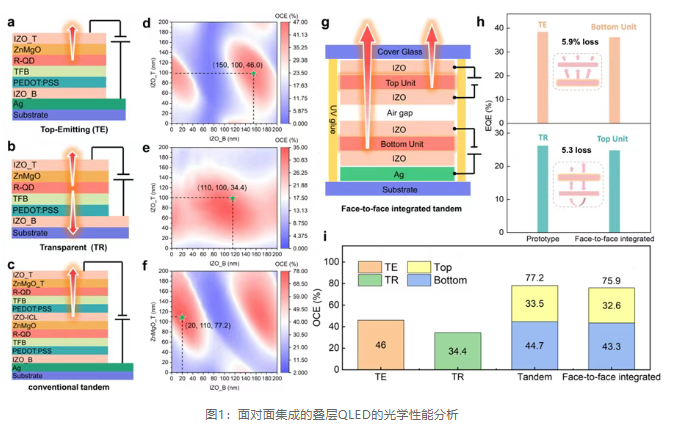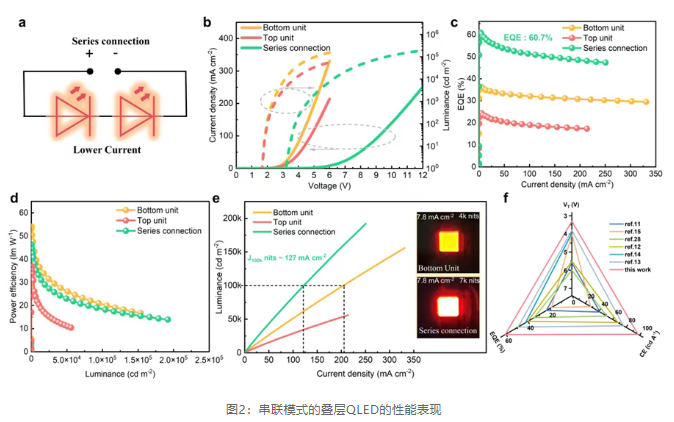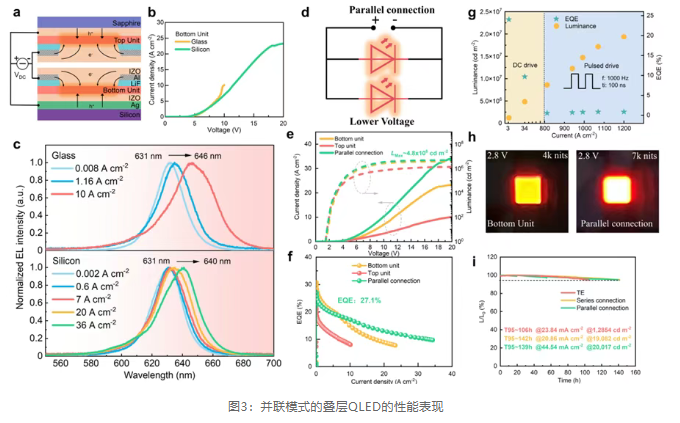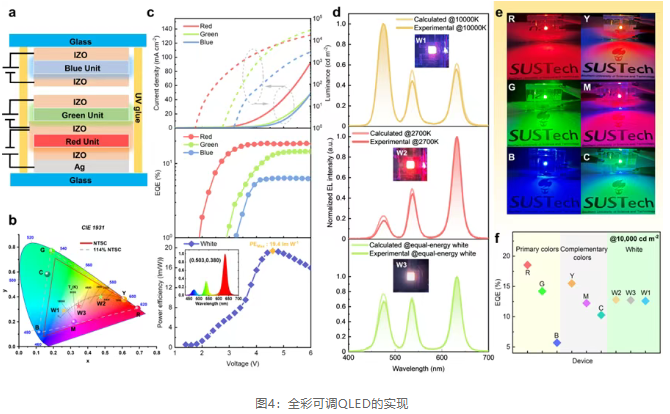16
2025
-
07
High-performance face-to-face integrated stacked QLED
Author:
The stacking technology of quantum dot light-emitting diodes (QLEDs) theoretically achieves a linear increase in device brightness and efficiency by vertically integrating multiple light-emitting units, bringing revolutionary opportunities to ultra-high-definition displays and solid-state lighting. However, traditional solution-processed stacked QLEDs have long faced three major technical barriers: 1) the intermediate electrical connection layer, charge injection difficulties caused by interfacial energy level mismatch; 2) film layer intermixing caused by solvent orthogonality failure, destroying interfacial quality; 3) device damage caused by multiple thermal annealing processes, severely restricting its performance improvement and long-term stability.
Addressing this industry pain point, Professor Chen Shuming's team innovatively proposed a "face-to-face integration" stacked device architecture. This strategy optimizes the luminous efficiency and charge transport performance of the top-emission unit and the transparent unit separately, and then achieves spatial coupling of the two units through high-precision alignment, breaking the physical and process limitations of the traditional series structure. This structure supports three working modes: series, parallel, and full-color adjustable, achieving breakthroughs in both brightness and efficiency, and successfully constructing a record-high-performance stacked QLED. The relevant research results are titled " Face-to-face integrated tandem quantum-dot LEDs with high performance and multifunctionality " and published in Light: Science & Applications .
Research Highlights
As shown in Figure 1, the research team systematically compared the optical coupling efficiency (OCE) of traditional stacked QLEDs and the new face-to-face integrated structure through optical simulation. Through precise optical microcavity design, the bottom unit and the top unit have high reflectivity and high transmittance respectively (both close to 95% at a wavelength of 630 nm), maximizing light utilization. Through rigorous calculation and verification, the OCE of this face-to-face integrated structure is 75.9%, comparable to the OCE (77.2%) of traditional stacked devices, and this structure has more flexible manufacturing processes, significantly reducing the risk of interlayer intermixing and stacking process steps, and achieving spatial vertical coupling of the two units through high-precision alignment. The two devices are packaged together and do not introduce additional optical elements to cause loss.

In the series connection mode, the stacked QLED exhibits almost ideal electrical characteristics: its turn-on voltage is 3.3 V, which is exactly equal to the sum of the turn-on voltages of the upper and lower units, indicating that the connection layer has achieved excellent electrical connection. At the same current density, the brightness is significantly better than that of conventional QLEDs. Figure 2f shows a comparison of key performance indicators of the stacked QLED in this paper with those reported in other literature. The EQE of this stacked QLED exceeds 60.7%, setting a new record for the highest reported stacked devices in the field.

The team explored the potential of face-to-face integrated stacked QLEDs in achieving ultra-high brightness. By matching substrates with excellent thermal conductivity (silicon substrate for the bottom unit and sapphire substrate for the top unit), the accumulation of internal heat can be effectively reduced so that the device can operate stably under high current density. At the same time, the voltage loss is reduced by introducing metal auxiliary electrodes. In parallel mode, the device can operate under a voltage as high as 20 V and a current density of 35 A/cm², and its luminous brightness finally exceeds 4.8 × 10⁶ cd/m². To further explore the potential of the device, a pulse power supply is used for driving, and the device can better dissipate heat during the pulse interval. After using 1 kHz, 100 ns pulse width pulse drive, the peak current density is further increased to 1200 A/cm², the instantaneous brightness exceeds 1 × 10⁷ cd/m², and a single-pulse output light energy of 1.66 J/cm² is achieved, which has the potential to be used as a high-performance optical pump excitation source.

The structure shown in Figure 4a innovatively integrates red, green, and blue primary color QLED units vertically, and each unit can be independently driven, thereby achieving precise adjustment of color, brightness, and color temperature. Combining spectral fitting and chromaticity inversion methods, the team can accurately match the driving voltage of the RGB sub-units under the preset color coordinates, achieving a super-wide color gamut coverage of 114% NTSC. As shown in Figure 4d, the obtained device white light spectrum is very consistent with the predicted spectrum, indicating the reliability of this adjustment mode. This structure shows strong scalability in applications such as smart lighting and personalized ambient lighting.

This research breaks the multiple limitations of traditional stacked QLEDs in process and structure. Through the idea of "face-to-face integration," high-performance stacked QLEDs have been successfully achieved. Thanks to its excellent performance and multi-functional characteristics, this method is expected to accelerate the application process of QLED technology in the lighting industry, and also lays a solid foundation for the extension of QLED to emerging fields such as photodynamic therapy, optical pump excitation, and photocatalysis.
LATEST NEWS
2025-12-17
Beijing Institute of Technology Review: Infrared Detectors for In-Memory Sensing and Computing
2025-12-17
High-performance III-V family infrared detectors
Since the advent of infrared detectors in the 1940s, their technological framework has undergone leapfrog development, with significant expansions in both device types and performance.

